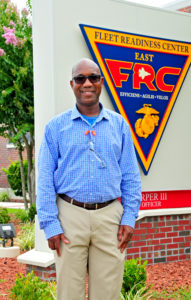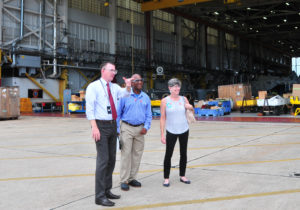 My summer internship
My summer internship
A conversation with an Engineer: What is a day like for an engineer at FRC East?
Growing up in Eastern North Carolina, I had seen the FRC East sign many times, however, it wasn’t until spending a little over three weeks here completing my internship and interacting with some of the more than 700 engineers that I now understand what happens at FRC East.
The Fleet Readiness Center East, whose mission is to generate combat air power for America’s Marines and Naval forces, could not remain operational without the engineers’, artisans’, chemists’, and mechanics’ roles in supporting the various aircraft in the fleet at Marine Corps Air Station Cherry Point.
My first excursion at FRC EAST was a tour of the facility with Jamaine, an engineer on staff. He explained that the mission is a dynamic and collective effort that involves everyone from the production artisans-who produce and repair the parts, to chemists in the lab-who analyze liquids. At the Fleet Readiness Center East, there are engineers who are involved in design and others have roles in investigations.
Support of an aircraft may begin wth a request. That request can be initiated from the shop, a pilot, routine PMI (periodic maintenance interval), or the need to design a new part on any of the aircraft that may have been damaged in battle beyond repair.
As we toured the hangar facility, I saw several of the aircraft that were in for PMI, as well as parts for other things at various stages of production in the engineering design process.
process.
According to Jamaine, there are two main types of engineers at FRC East: PSEs (Production Support Engineers) and FSEs (Fleet Support Engineers). Production support engineers can be specialized in certain areas and they generally support production of a part of an aircraft. FSEs support the fleet directly. They can talk to pilots, artisans, and mechanics to generate an inquiry to solve a problem. FSEs and PSEs both have to understand and view things from a systems perspective to be able to communicate with the diversity of personnel to identify an engineering design challenge.
Looking over at some of the aircraft being maintained, Jamaine explained that work on that aircraft involves several teams: a team of artisans, an estimation and evaluation team, a quality assurance team, and a production control team, all of whom must work together with the engineers who create, approve and maintain design schematics and specifications for paints, coating, oils, and metals.
Engineering involves a “business aspect”, as well. Engineers must not only focus on designing, but also have to meet timelines and be effective communicators while following the engineering design process. They can never compromise on safety or quality.
Later during the week, I met with one of the chemical engineers at FRC East. Robbie and his team support the aircraft at Marine Corps Air Station through structural investigations and research and development of non-destructive metals. They work to identify the best combinations and concentrations of paints and coatings as well as develop, perform, and analyze stress tests for certain metals.
Additionally, I had a chance to meet with Josh, a materials engineer who works as an investigative engineer at FRC East. His focus is failure analysis. He performs forensic analysis of materials.
I had the opportunity to observe how he and his team work backwards to understand the lessons learned from a mishap and to create new designs. As Josh stated, “Even out of failure, new design can occur.”
Then, I met with Nicholas, a digital production engineer at FRC East. As he stated, “Pure design rarely occurs here. Most of the design that we do, is custom repair.”
Nicholas uses CAD software to 3D print model specific parts that may have been created from the OEM (Original Equipment Manufacturer) blueprint.
One of the last engineers that I had a chance to shadow was Patrick, a production support engineer. Patrick and his team are a “design heavy” group. As he explained, they design a lot of the equipment used to test, repair, and maintain the components that ensure the air worthiness of the fleet. One of the more interesting things that I did was to witness the design process from initial idea to completed product. I watched as the inquiry began with a work order. As Patrick explained, the order came from a mechanic on the floor who needed a more efficient tool to repair an particular aircraft. From there, a team of engineers look at the requirements, specifications, and tolerances of material to decide if the idea is feasible, safe, and cost-efficient. Then, the design team presents a PDR (preliminary design review), and later a CDR (critical design review). There is a great deal of collaboration and questions even at this phase of the engineering design process. From here, the engineers create a prototype model. This can be a 3-D printed model generated from a CAD (Computer Animated Design) software sketch or a working prototype created in the mechanic’s shop. At this point of the design, the model is checked and revised. If it meets approval, then the model is finalized and manufactured.
It has been said that the internship is the “heart of the fellowship”, thus incorporating all of my vast and extraordinary experience with the engineers at FRC East into rich classroom lessons and practices that will impact my classroom and others will be essential.
According to a recent article I read about the top skills that students will need to be successful in the 21st century, coordinating with others, complex problem solving skills, critical thinking skills, and creativity are among them. Some of my main practices and lesson plans will be heavily rooted in Collaboration, Creativity, Critical thinking and Problem solving skills.
Among the many successes during my internship, being immersed in a STEM career for the past three weeks has been my number one success. I have seen that the kinds of problems that engineers solve inherently involve collaboration, creativity, and critical thinking. Going forward, all of the activities that I use in my classes will now focus on STEM. This will help me teach the English learners that I work with to develop these skills while simultaneously acquiring English.
Another huge success of my internship, in addition to witnessing STEM careers up close, is that I also have made connections and have networked with engineers who can help me to incorporate authentic STEM activities into my classrooms.
My internship has allowed me to see how engineers and careers function on a systems level. Witnessing this has given me insight to how I can begin to restructure some of my relationships with other educators going forward, which I view as a challenge.
It will also be comforting to know that while developing these skills, I will also be exposing my students to some of the fastest-growing careers over the next twenty years so they will have an opportunity to explore these career paths to find their calling.
